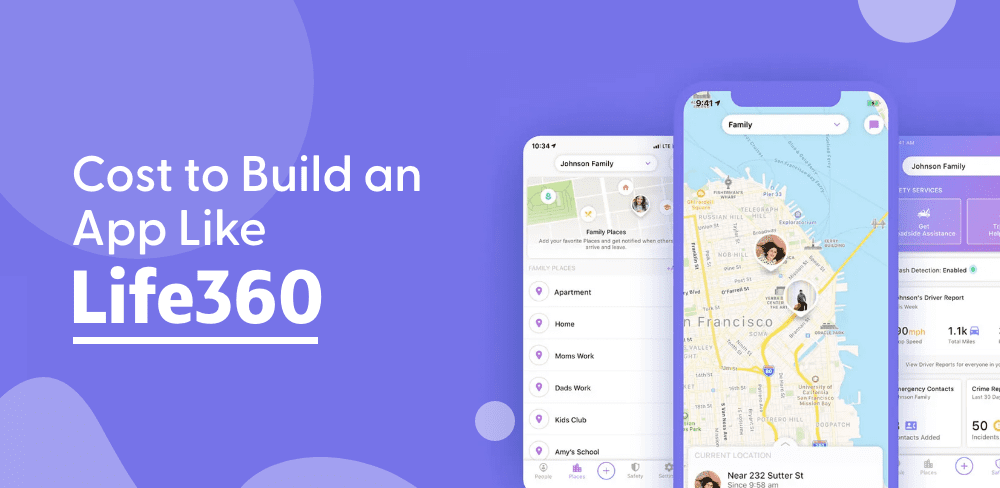Life360 is a great example of how location-sharing apps and family safety are becoming more popular in our digital age. Have you ever thought about how much it would cost to build an app like life360? We will take you on a journey to learn about the intricacies involved with building an app such as Life360 and the financial implications that go along with it.
A comprehensive process is required to build an app like life360. It includes creating user-friendly interfaces and integrating GPS tracking. It also involves providing real-time notifications, as well as ensuring security. Costs can vary widely depending on features, platforms, and complexity of development.
We will explore the key components that affect the budget to help you better understand the financial investment needed for this app development journey. If you’re interested in the cost to build an app like life360, keep reading to learn about the main factors.
What is the Life360 App?
Life360, a popular app for family safety, offers features such as location sharing, communication, and safety. The app allows users to see each other’s locations in real-time on a map. They can also set geofencing for certain areas and send messages. It also offers features for driving safety, including crash detection and emergency response.

Life360 was designed to improve family communication and give peace of mind by ensuring loved ones’ safety and well-being. It’s available on a variety of platforms, which makes it an invaluable tool for families who want to stay in touch and know where each other is.
Major 10 Factors That Affect The Cost To Build an App Like Life360
The cost to build an app like life360 is influenced by a number of factors. We’ll look at the 10 major factors that have a significant impact on the costs associated with the process to build an app like life360.
1. App Features and Complexity
Costs to build an app like life360 are determined by the number of features and their complexity that you want to include. Features such as geofencing and real-time tracking of location, group chats, emergency alerts, and even other functionalities, like driving statistics or crime statistics integration, can increase the development time and costs.
2. Platform Selection
The platform you choose will have a significant impact on the cost to build an app like life360. The development of apps for iOS, Android, and other platforms, such as web and wearables, requires additional testing and development efforts. You will also need to decide whether you are going to create native apps or cross-platform frameworks for each platform.
3. Designing User Interfaces (UI) or User Experiences (UX)
User engagement is dependent on a well-designed, intuitive UI/UX. To create a design that is both visually appealing and easy to use, you will need time and expertise. The cost to build an app like life360 can be higher if you use more complex designs, animations, and custom graphics.
4. GPS Integration
GPS integration is crucial for apps such as Life360 that rely on location tracking. The cost of GPS integration can vary depending on how precise the mapping is and whether there are any available APIs. GPS integration is more complex and expensive, with features such as real-time tracking, geofencing, and historical location data.
5. Security Measures
Assuring privacy and security for user data is of paramount importance. Implementing robust security measures, such as end-to-end encryption, secure authentication of users, and secure storage of data, takes time and expertise. It adds to the development costs.
6. Server Infrastructure
You’ll need a scalable server infrastructure to handle user data and track users in real-time. Costs to build an app like life360 vary depending on factors such as the number of users and data that is stored. Also, redundancy or failover features are needed.
7. Third-Party Integrations
Integration of third-party APIs and services can improve your app’s functionalities, but it often incurs additional costs. If you want to add weather data, traffic updates, or crime statistics to your app, for example, you will need to pay.
8. Regulatory Compliance
Life360, a family safety app, must often comply with various regulations relating to privacy, location tracking, and child safety. Legal consultations and additional development may be required to ensure compliance with these regulations, which could add costs.
9. Testing and Quality Assurance
To deliver bug-free and reliable fitness app development, rigorous testing and quality control are essential. The time spent on testing and addressing issues, including those found in different devices, platforms, and network conditions, as well as the cost, are increased by testing and addressing them.
10. After-Launch Maintenance and Updates
The development of an app continues after its initial release. To keep the app relevant and free of bugs, you’ll have to update and maintain it continuously. It includes adding new features and fixing bugs, as well as optimizing performance.
How To Reduce the Cost To Build an App Like Life360?
Reducing the cost to build an app like life360 without compromising quality or functionality can be a strategy. Here are some effective ways to control development costs.
1. MVP (Minimum Viable Product) Approach
Build a Minimum Viable product with just the essential features. You can test the concept and functionality of your app with minimal mobile app development costs. You can add features and improve your app as you get feedback from users and validate your concept. It will make development cost-effective.
2. Open-Source Tools and Third-Party Software
Use open-source libraries or third-party tools as much as possible. These resources will save you money and time by offering pre-built solutions to common problems like map integration, notification pushes, or authentication. Be sure to check the licensing and terms of usage to make sure that your Life360 App development is compatible.
3. Cross-Platform Development
Consider cross-platform frameworks such as React Native, Flutter, or Xamarin. These frameworks allow you to write code only once and deploy it across multiple platforms. It reduces android app development time and costs when compared with building native apps for iOS or Android.
4. Outsourcing Development
It is possible to reduce costs by outsourcing development to countries with lower labor costs, like Eastern Europe, Asia, or South America. Choose a mobile app development company who has a proven track record and is able to communicate effectively.
5. Hybrid App Development
Web-based apps wrapped in native shells are hybrid apps. They may not have the same performance as native apps, but they can be a cheaper solution for apps without complex native features.
6. Agile Development
Agile methodologies such as Scrum and Kanban can reduce costs by allowing for flexibility in the scope and direction of a project. Your app can be adapted to user feedback, and you won’t have to develop unnecessary components.
7. In-House Development Team
Long-term, if you have the resources and expertise to do so, hire indian app developers is a cost-effective option. You can have more control over your project and its ongoing development. It could reduce long-term costs compared to using external partners.
8. App Monetization Strategies
Plan your app’s revenue strategy carefully. Consider a freemium strategy, which offers a limited version of the app for free and charges for subscriptions or premium features. Advertisements in-app and partnerships with brands relevant to the app can generate revenue that will offset cost to build an app like life360.
9. Continuous Monitoring and Optimisation
Use app analytics to track user behavior and gain insights. These data can be used to optimize your app, improve the user experience, and focus resources on the most valuable features.
10. Serverless Architecture
Consider using a serverless infrastructure for your backend. AWS Lambda and Google Cloud Functions let you pay only for what you use. It reduces the costs of maintaining and scaling your servers.
11. Data Storage Efficiency
Optimize the way you manage and store user data. Use data compression to reduce storage needs. Cloud storage services can be scaled to your needs and reduce upfront infrastructure costs.
12. Progressive Web Apps
A Progressive Web App (PWA) is a web app that can be accessed via a browser and provides a native-app-like experience. PWAs are more cost-effective to develop than native apps, particularly if the app’s core functions don’t require extensive access to devices.
13. Localize Development
Focus on one platform at a time. It helps control costs and allows for fine-tuning your app according to user feedback before you expand to other platforms or markets.
14. UI/UX Optimization
A high-quality design can be maintained without using extravagant design elements. The design process can be streamlined to save time and money. Consider using pre-designed UI kits for faster development.
15. Freelancers, Part-Time Resources and Other Resources
Consider to hire dedicated developers to perform specific tasks if you do not need a development team. It will reduce your labor costs and give you more flexibility when allocating resources.
16. Non-essential Features
Prioritize non-essential functions. Decide if certain features can be deferred for future updates or even removed. Focus on core features that will provide the greatest value to your audience.
17. Testing Strategies
Use effective testing strategies early in the development cycle to identify and fix issues. Automation tools and frameworks will streamline the testing process, reducing the need for manual testing.
18. Refactoring Code and Reusing it
Hire mobile app developers to create clean, reusable codes. It can save you time and energy when developing new features or fixing bugs in the future. Refactoring code can improve performance and maintainability.
19. Documentation and Knowledge Exchange
Documentation of the architecture, codebase, and processes is essential. It will help new team members to understand the project quicker and reduce errors, which in turn reduces the time & cost to build an app like life360.
20. Negotiate with Service Providers
Negotiate pricing for third-party services such as cloud computing or payment gateways based on usage. Some service providers will offer you discounts or custom pricing for your project.
What is The Accurate Cost To Build An App Like360?
The exact costs associated with developing an app similar to Life360 depend on many factors, including the size of the application, its feature set, the technology stack, and complexity. The average Life 360 App development cost is between $8,000 and $30,000, depending on other factors.
Opting for a Life 360 app development company that is reputable can make the process of development more cost-effective. You can also hire dedicated developers who will help you build an app like life360 for a reasonable price.
Read Also: Build a Fitness App
|
Category |
Cost Range |
|
Planning and Design |
$2,000 – $5,000 |
|
Development |
$10,000 – $30,000 |
|
Testing and QA |
$5,000 – $8,000 |
|
Deployment |
$3,000 – $7,000 |
|
Security and Compliance |
$5,000 – $8,000 |
|
Maintenance and Support |
$5,000 – $10,000 |
|
Marketing and Launch |
$10,000 – $15,000 |
This table is a cost estimate for the development of a location-tracking app. This table will help you plan your project based on the estimated budget to build an app like Life360.
Conclusion
The cost to build an app like life360 can be very different depending on the features, complexity, and resources available. You can expect to pay anywhere from $8,000 up to $30,000, but the costs may be lower if you hire iOS app developers to develop apps. When embarking on such a project, it’s crucial to take into account your budget and specific requirements.
Frequently Asked Questions
1. How Much Does It Cost To Build An App Like Life360?
The cost to build an app like Life360 can vary widely depending on features, complexity, and development location. A basic version might cost around $8,000 to $15,000, while a more advanced one could cost $25,000 or more.
2. How Long Does It Take To Build An App Like Life360?
Developing an app like Life360 typically takes around 4 to 9 months. However, the timeline can be shorter or longer based on the app’s features and the development team’s size and expertise.
3. What Are The Benefits of Investing in an App Like Life360?
Investing in an app like Life360 offers benefits such as enhanced family safety, real-time location sharing, geofencing, and emergency alerts, making it a valuable tool for keeping loved ones safe and connected.
4. Why Should You Choose Dev Technosys for Building an App Like Life360?
Dev Technosys is a reliable choice for building an app like Life360 due to its experience, skilled development team, and track record of creating location-based apps. They offer a comprehensive range of development services.
5. What Are Popular Apps Like Life360?
Popular apps similar to Life360 include “Family Locator – GPS Tracker,” “Zenly,” “Find My Friends,” and “Glympse.” These apps provide various features for location tracking and family safety.










